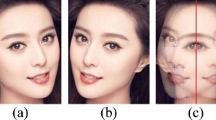Abstract
A generalized neural reflectance (GNR) model for enhancing face recognition under variations in illumination and posture is presented in this paper. Our work is based on training a number of synthesis images of each face taken at single lighting direction with frontal/posture view. This way of synthesizing images can be used to build training cases for each face under different known illumination conditions from which face recognition can be significantly improved. However, reconstructing face shape may not easily be achieved and the human face images usually form by highly complex structure which suffers from strong specular and unknown reflective conditions. In this paper, these limitations are addressed by Cho and Chow (IEEE Trans Neural Netw 12(5):1204–1214, 2002). Face surfaces are recovered by this GNR model and face images in different poses are synthesized to create a database for training. Our training algorithm assigns to recognize the face identity by similarity measure on face features extracting first by the principle component analysis (PCA) method and then further processing by the Fisher’s discrimination analysis (FDA) to acquire lower dimensional patterns. Experimental results conducted on the Yale Face Database B show that lower error rates of classification and recognition are achieved under different variations in lighting and pose and the performance significantly outperforms the recognition without using the proposed GNR model.










Similar content being viewed by others
References
Pentland A, Choudhury T (2000) Face recognition for smart environments. Computer 33(2):50–55
Samil A, Iyengar P (1992) Automatic recognition and analysis of human faces and facial expressions: a survey. Pattern Recognit 25:65–77
Chellappa R, Wilson CL, Sirohey S (1995) Human and machine recognition of faces: a survey. Proc IEEE 83:705–740
Zhao W, Chellappa R, Rosenfeld A (2000) Face recognition: a literature survey. Technical Report, CAR-TR948, University of Maryland
Ekman P (1992) Facial expressions of emotion: an old controversy and new findings. Philos Trans R Soc Lond 335:63–69
Kanade T (1973) Picture processing by computer complex and recognition of human faces. PhD dissertation, Kyoto University
Brunelli R, Poggio T (1993) Face recognition: features versus templates. IEEE Trans Pattern Anal Mach Intell 15:1042–1052
Gao Y, Leung MKH (2002) Face recognition using line edge map. IEEE Trans Pattern Anal Mach Intell 24(6):764–779
Sutherlan K, Renshaw D, Denyer PB (1992) Automatic face recognition. In: Proceedings of the 1st international conference on intelligent systems engineering. IEEE Press, Piscataway, pp 29–34
Turk M, Pentland A (1991) Eigenfaces for recognition. J Cognit Neurosci 3:71–86
Belhumeur PN, Hespanha JP, Kriegman DJ (1997) Eigenfaces vs Fisherfaces: recognition using class specific linear projection. IEEE Trans Pattern Anal Mach Intell 19(7):711–720
Lawrence S, Giles CL, Tsoi AC, Back AD (1997) Face recognition: a convolution neural-network approach. IEEE Trans Neural Netw 8:98–113
Lin S-H, Kung S-Y, Lin L-J (1997) Face recognition/detection by probabilistic decision-based neural network. IEEE Trans Neural Netw 8:114–132
Er MJ, Wu S, Lu J (2002) Face recognition with radial basis function (RBF) neural networks. IEEE Trans Neural Netw 13(3):697–710
Pankanti S, Bolle RM, Jain A (2000) Guest editors’ introduction: biometrics—the future of identification. Computer 33(2):46–49
Hallinan P (1994) A low-dimensional representation of human faces for arbitrary lighting conditions. In: Proceedings of IEEE conference on computer vision and pattern recognition, pp 995–999
Hallinan P (1995) A deformable model for face recognition under arbitrary lighting conditions. PhD thesis, Harvard University
Adini Y, Moses Y, Ullman S (1997) Face recognition: the problem of compensating for changes in illumination direction. IEEE Trans Pattern Anal Mach Intell 19:721–732
Sali E, Ullman S (1998) Recognizing novel 3-D objects under new illumination and viewing position using a small number of example views or even a single view. In: Proceedings of IEEE conference on computer vision and pattern recognition, pp 153–161
Cho SY, Chow TWS (2001) Enhanced 3D shape recovery using the neural-based hybrid reflectance model. Neural Comput 13:2617–2637
Hallinan P, Gordon G, Yuille A, Mumford D (1999) Two- and three-dimensional patterns of the face. A.K. Peters, Wellesley
Beymer D (1994) Face recognition under varying pose. In: Proceedings of IEEE conference on computer vision and pattern recognition, pp 756–761
Huang F, Zhou Z, Zhang H, Chen T (2000) Pose invariant face recognition. In: Proceedings of IEEE international conference on automatic face and gesture recognition, pp 245–250
Georghiades AS, Belhumeur PN, Kriegman DJ (2001) From few to many: illumination cone models for face recognition under variable lighting and pose. IEEE Trans On Pattern Anal Mach Intell 23(6):643–660
Healy G, Binford TO (1988) Local shape from specularity. Comput Vis Graph Image Process 42:62–86
Torrance KE, Sparrow EM (1967) Theory for off-specular reflection from roughened surfaces. J Opt Soc Am 57:1105–1114
Nayar SK, Ikeuchi K, Kanade T (1991) Surface reflection: physical and geometrical perspectives. IEEE Trans Pattern Anal Mach Intell 13:611–634
Nayar SK, Ikeuchi K, Kanade T (1990) Determining shape and reflectance of hybrid surfaces by photometric sampling. IEEE Trans Robot Autom 6:418–430
Hornik K, Stinchcombe M, White H (1989) Multilayer feedforward networks are universal approximation. Neural Netw 2:359–366
Park J, Sandberg IW (1991) Universal approximation using radial basis function networks. Neural Comput 3:261–257
Cho SY, Chow TWS (2002) Neural computation approach for developing a 3-D shape reconstruction model. IEEE Trans Neural Netw 12(5):1204–1214
Atick JJ, Griffin PA, Redlich AN (1996) Statistical approach to shape from shading: reconstructions of three-dimensional face surfaces from single two-dimensional images. Neural Comput 8:1321–40
Swets DL, Weng J (1996) Using discriminant eigenfeatures for image retrieval. IEEE Trans Pattern Anal Mach Intell 18:831–836
Acknowledgements
The authors would like to thank the anonymous reviewers for their valuable comments. The work was supported by School of Computer Engineering, Nanyang Technological University, Singapore under a start-up research grant (CE-SUG 10/03).
Author information
Authors and Affiliations
Corresponding author
Rights and permissions
About this article
Cite this article
Cho, SY., Chow, T.W.S. Robust face recognition using generalized neural reflectance model. Neural Comput & Applic 15, 170–182 (2006). https://doi.org/10.1007/s00521-005-0017-7
Received:
Accepted:
Published:
Issue Date:
DOI: https://doi.org/10.1007/s00521-005-0017-7




